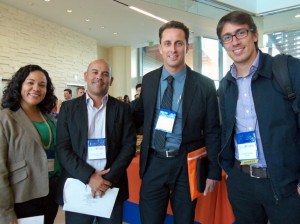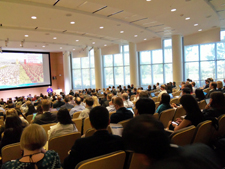“On a global perspective,” Leiner continued, “agencies are still evolving their perception and evaluation of the risks that are related to bioequivalence of inhaled and nasal products. Presentations on the current situation for inhaled products in Europe, China, Brazil, India were helpful. Importantly, the FDA elaborated on its position on the ‘weight-of-evidence’ approach, which is based on three pillars: sameness of in vitro performance, sameness of PK results and sameness of PD results. Human factor aspects may be added as a fourth pillar.”

Raquel Silva (ANVISA), Leonardo Costa (ANVISA), Mauricio Sampaio (EMS), and Gustavo Santos (ANVISA)
Organizers from the University of Florida also expressed happiness with the mix of participants and the relevance of the presentation topics.
UF Professor of Pharmaceutics Guenther Hochhaus said, “Overall, I believe the meeting was a great success, especially the open interaction among 200 participants from industry, international regulators and academia. A number of participants stressed that cutting edge research in all relevant areas, including in vitro assays, new statistical approaches, device similarity, clinical studies, and biomarkers, was blended in an attractive way with timely presentations on the international regulatory landscape provided by the FDA, EMA and ANVISA, plus assessments on the Asia-pacific region.”

Attendees at the Orlando Inhalation Conference packed the auditorium at the University of Florida Research and Academic Center
Hochhaus cites keynote addresses by Anthony Hickey of RTI International and by Lawrence Yu of the FDA as highlights.
For University of Florida Pharmacy and Pediatrics Professor Leslie Hendeles, a former member of the FDA’s Pulmonary Allergy Drug Advisory Committee, the conference “was an outstanding opportunity for industry, regulators such as FDA and academics to interact and discuss issues relevant to making generic inhaled drugs available to patients and thus decrease the cost of therapy.”Leiner also noted that the meeting “offered an unusually open atmosphere for discussions and was rated excellently by attendees.”
Attendee Orest Lastow of the Medicon Valley Inhalation Consortium, concurred, saying that he was able to see everyone in the industry that he needed to see at the meeting and found the presentations particularly useful since they were “by the industry, for the industry and very practical — much less academic than many of the other meetings in the field.”
View the complete agenda and presentations from the Orlando Inhalation Conference.


